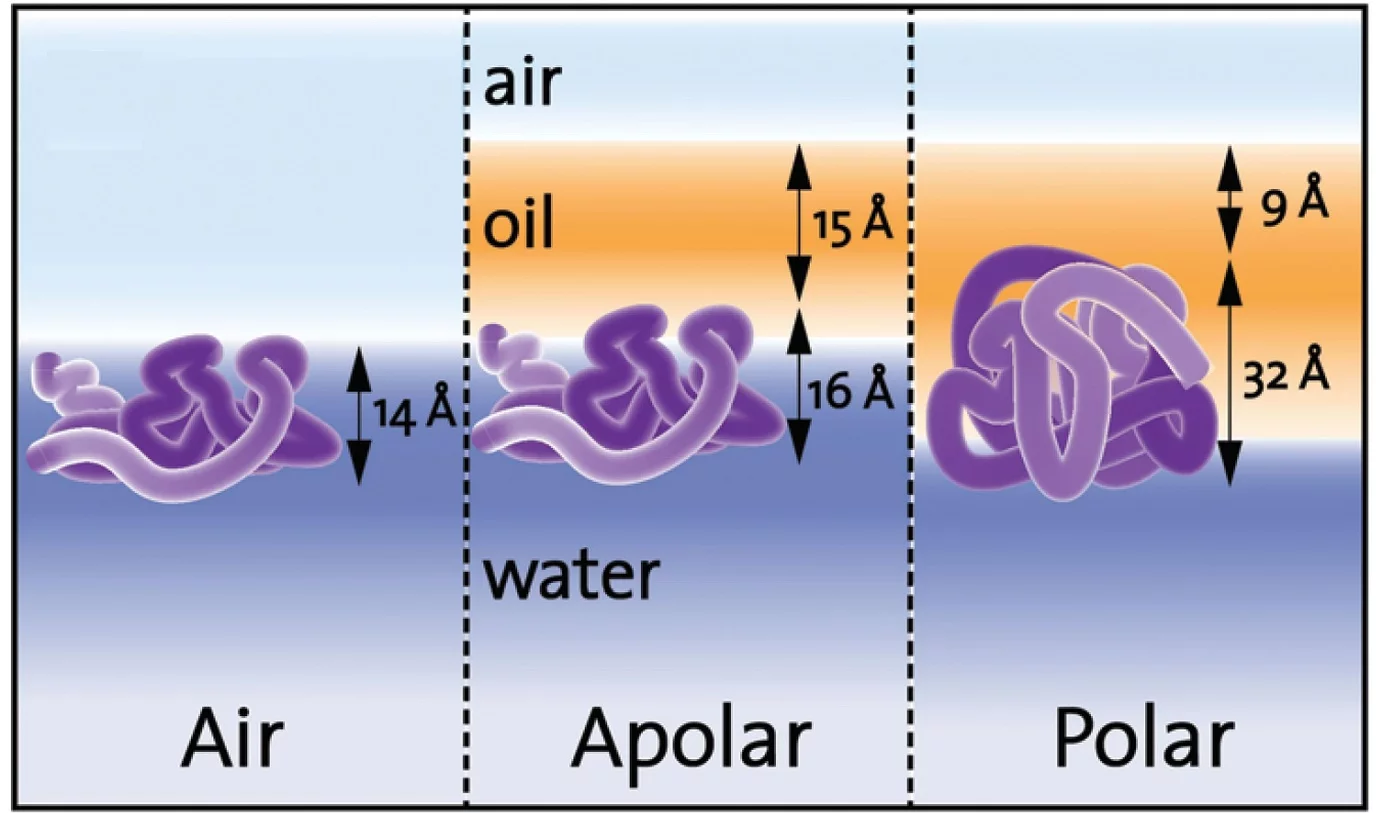Nanocrystalline cellulose (NCC) and cellulose nanofibrils (CNF) as a novel type of biomacromolecules have attracted attention as a biological alternative for the stabilization of air−water (A/W) and oil−water (O/W) interfaces, allowing the creation of cellulose-based colloidal materials. These materials offer a wide range of applications, such as lightweight aerogels with insulating or fire-retardant properties, oil adsorbents, paper-based energy storage devices, or biocompatible encapsulation systems.
However, adsorption kinetics, interfacial structure, and mechanical properties of adsorbed NCC/CNF layers are mostly unknown due to the current inability to form reproducible NCC/CNF layers required for interfacial thin film techniques. This stresses the need for finding suitable parameters and methods for the formation and characterization of the investigated interfacial layers. The formation of viscoelastic networks made of globular proteins at fluid interfaces have also come into focus.
In the framework of this project, adsorption was studied depending on NCC/CNF concentration and salt-induced charge screening. The interfacial morphology was determined by atomic force microscopy (AFM) and neutron reflectometry while dynamic and mechanical properties of pure NCC and composite layers were investigated by Wilhelmy-plate technology and interfacial shear rheology.
Publications
- N. Scheuble, T. Geue, E. Windhab, and P. Fischer, „Tailored interfacial rheology for gastric stable layers”, Biomacromolecules 2014, 15, 3139
- N. Scheuble, T. Geue, S. Kuster, J. Adamcik, R. Mezzenga, E. J. Windhab, and P. Fischer, „Mechanically enhanced liquid interfaces at human body temperature using thermosensitive methylated nanocrystalline cellulose”, Langmuir 2016, 32, 1396-1404
- Nathalie Scheuble, Micha Lussi, Thomas Geue, Frédéric Carrière and Peter Fischer, “Blocking Recombinant Dog Gastric Lipase Adsorption and Displacement Processes with Viscoelastic Biopolymer Adsorption Layers”, Biomacromolecules 2016, 17, 3328
- Th Geue, P Fischer, N Scheuble, E Windhab, K Wojciechowski, Th Gutberlet, “Neutron reflectometry: A powerful tool to characterize biofilms at interfaces”, European Cells & Materials 2016, 32 (5), 90
- Merel E.H. van den Berg, Simon Kuster, Erich J. Windhab, Jozef Adamcik, Raffaele Mezzenga, Thomas Geue, Leonard M.C. Sagis, and Peter Fischer, "Modifying the contact angle of anisotropic cellulose nanocrystals: Effect on surface rheology and microstructure", Langmuir 2018, 34, 10932
- Pascal Bertsch, Michael Diener, Jozef Adamczik, Nathalie Scheuble, Thomas Geue, Raffaele Mezzenga, and Peter Fischer, “Adsorption and Interfacial Layer Structure of Unmodified Nanocrystalline Cellulose at Air/Water Interfaces”, Langmuir 2018, 34, 15195
- P. Bertsch, A. Thoma, J. Bergfreund, Th. Geue, and P. Fischer, “Transient measurement and structure analysis of protein-polysaccharide multilayers at fluid interfaces”, Soft Matter 2019, 15, 6362
- P. Bertsch, M. Arcari, Th. Geue, R. Mezzenga, G. Nyström, and Peter Fischer, “Designing cellulose nanofibrils for stabilization of fluid interfaces”, Biomacromolecules 2019, 20,12,4574
- Pascal Bertsch, Michael Diener, Jozef Adamczik, Nathalie Scheuble, Thomas Geue, Raffaele Mezzenga, and Peter Fischer, “Correction to Adsorption and Interfacial Layer Structure of Unmodified Nanocrystalline Cellulose at Air/Water Interfaces”, Langmuir 2020, 36 (7), 1848
- Jotam Bergfreund, Michael Diener, Thomas Geue, Natalie Nussbaum, Nico Kummer, Pascal Bertsch, Gustav Nyström and Peter Fischer, ”Globular protein assembly and network formation at fluid interfaces: effect of oil”, Soft Matter 2021, 17, 1692
Collaboration
- Prof. Peter Fischer, D-HEST ETHZ
- Prof. Erich J. Windhab, D-HEST ETHZ
- Prof. Jan Vermant, D-MATL ETHZ
Funding
- SNF project 200021_137941
- SNF project 200021_146735
- SNF project 200021_159898
- SNF project 200021_175994
- SNF R’Equip 206021_177018
Associated junior researchers
- Nathalie Scheuble, PhD ETHZ 2016, ETHZ thesis medal 2017
- Merel E. H. van den Berg, PhD ETHZ 2017
- Pascal Bertsch, PhD ETHZ 2020
- Jotam Bergfreund, PhD ETHZ ongoing
